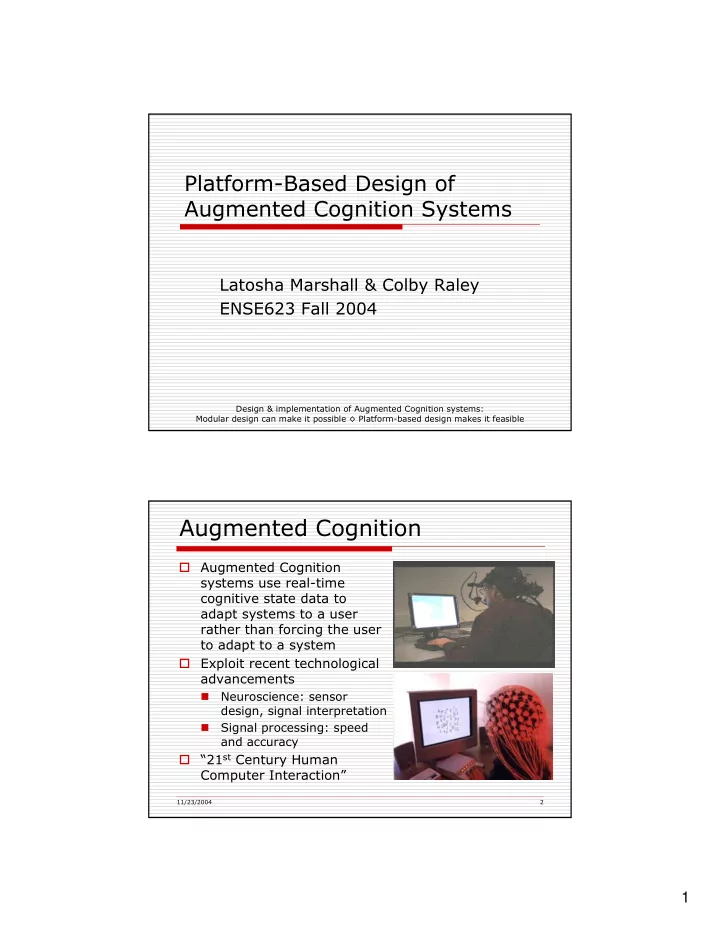

Platform-Based Design of Augmented Cognition Systems Latosha Marshall & Colby Raley ENSE623 Fall 2004 Design & implementation of Augmented Cognition systems: Modular design can make it possible ◊ Platform-based design makes it feasible Augmented Cognition � Augmented Cognition systems use real-time cognitive state data to adapt systems to a user rather than forcing the user to adapt to a system � Exploit recent technological advancements Neuroscience: sensor � design, signal interpretation Signal processing: speed � and accuracy � “21 st Century Human Computer Interaction” 11/23/2004 2 1
Augmented Cognition Enablers Discipline System Aspect Neuroscience Sensors: development & placement Math: Gauges: Signal Processing Development Artifact Detection Ensuring meaningful information Psychology: Operator Environment: Human Factors Interface design Neuroergonomics Interface design Engineering: System Design: Mechanical Physical Components Electrical Component Communication Systems Information Flow Cognitive Systems “Bringing the Human in the Loop” 11/23/2004 3 System Architecture cognitive model user sensor cognitive state Augmentation environmental model Manager state + task + environment sensor environmental state environment = interface mitigation strategy; apply mitigation task model strategy task sensor task state autonomous agents command 11/23/2004 4 2
System Architecture - Inputs User � Any person interacting with an augmented � cognition system In a driving environment: the driver � In a learning environment: the student � Environment � The environment in which the system is � being implemented In a driving environment: the car and its � current surroundings In a learning environment: the classroom � and any equipment being used Task � The task that the user is completing; using � the augmented cognition system to improve performance In a driving environment: driving (or � navigating to an objective) In a learning environment: concept mastery � 11/23/2004 5 System Architecture - Models Cognitive Model � User Model � � Computational model for how people perform tasks and solve problems, based on psychological principles Enable the prediction of the time it � takes for people to perform tasks, the kinds of errors they make, the decisions they make, etc… Context Models � Environmental Model � Incorporates known information � about the task environment enable a context-aware environment Task Model � Incorporates known information � about the task/objective to understand and predict the task that a user is completing � Necessary for accurate timing of mitigation strategy execution Comparison of Context Classification Systems 11/23/2004 6 3
Platform-Based Design Platform-based design goes beyond � modular design to incorporate information about the application environment into the design process. Platform-based design combines top- � down and bottom-up design approaches Top Down � Platform-mandated constraints � Connections and communications � between components Consideration of system-level goals � Bottom Up � Component-mandated constraints � Benefits of platform-based design � include Reuse of designed components � Reduced design cycle time � Component “swapping” during design � process 11/23/2004 7 Alberto Sangiovanni Vincentelli. Defining Platform-based Design. EEDesign of EETimes, February 2002. Platforms of Interest � Cockpit � Driving Airplane � � Control Station Unmanned Vehicle Interface � Air Traffic Control � Command Post of the Future � � Learning Environment Virtual Reality � � Classroom 11/23/2004 8 4
Component Catalog Sensors � Interfaces � � Cognitive Visual � � Direct Brain Measures � Heads up display EEG � � Traditional display fNIR � � Alert � Psychophysiological Measures HR, EKG � Warning � Pulse Ox � � Picture Posture � � Text GSR � Temperature Auditory � � EOG � � Voice Pupilometry � � Warning Gaze Tracking � Environmental � � Spatially locatable � Platform Measures Tactile � � Location � Warning � Internal Conditions � Directional cue � Fuel � Weapons � External Measures Weather � � Presence of Chemical or Biological Agents � Situational Awareness � Hostility Obstacles � Task � � Status 11/23/2004 9 Component Catalog - Driving Sensors � Interfaces � � Cognitive Visual � � Direct Brain Measures � Heads up display EEG � � Traditional display fNIR � � Alert � Psychophysiological Measures HR, EKG � Warning � Pulse Ox � � Picture Posture � � Text GSR � Temperature Auditory � � EOG � � Voice Pupilometry � � Warning Gaze Tracking � Environmental � � Spatially locatable � Platform Measures Tactile � � Location � Warning � Internal Conditions � Directional cue � Fuel � Weapons � External Measures Weather � � Presence of Chemical or Biological Agents � Situational Awareness � Hostility Driving Obstacles � Task � � Status 11/23/2004 10 5
System Architecture – Driving Components 11/23/2004 11 System Architecture - Driving cognitive model Cognitive Sensors: of driving EEG, fNIR driver cognitive state Physiological Sensors: EOG, EKG, HR, pupilometry, gaze tracking, PO, posture, body temp, GSR environmental model Vehicle sensors: gas of car and road gauge, speedometer, Augmentation odometer Manager Interfaces: audio system, cell phone system, visual car & road state + task + environmental state alert system, automatic environment = braking/ steering/ mitigation strategy; Context sensors: lane between-car-distance apply mitigation departure, obstacle strategy* detection (IR, visual), temperature, heading, wind speed, location task model: driving and secondary tasks Mitigation Strategies - Driving • Modality Switching • Task Ordering Distance, task • Attention Directing task / completion, # tasks task state objective in progress 11/23/2004 12 6
Recommend
More recommend